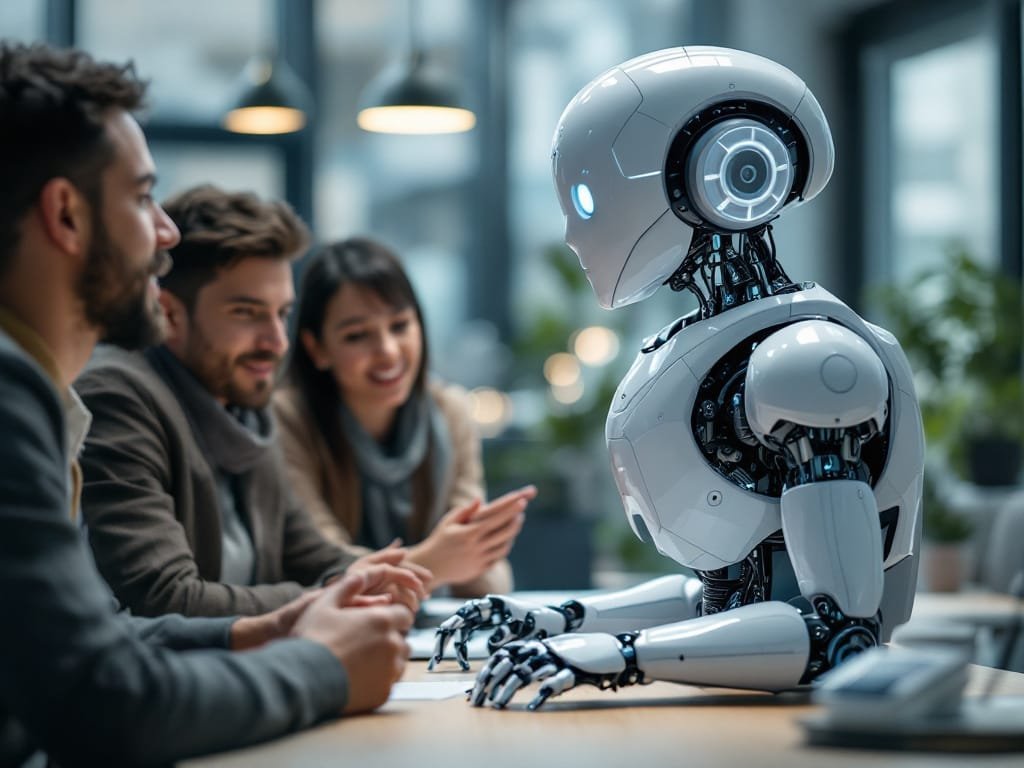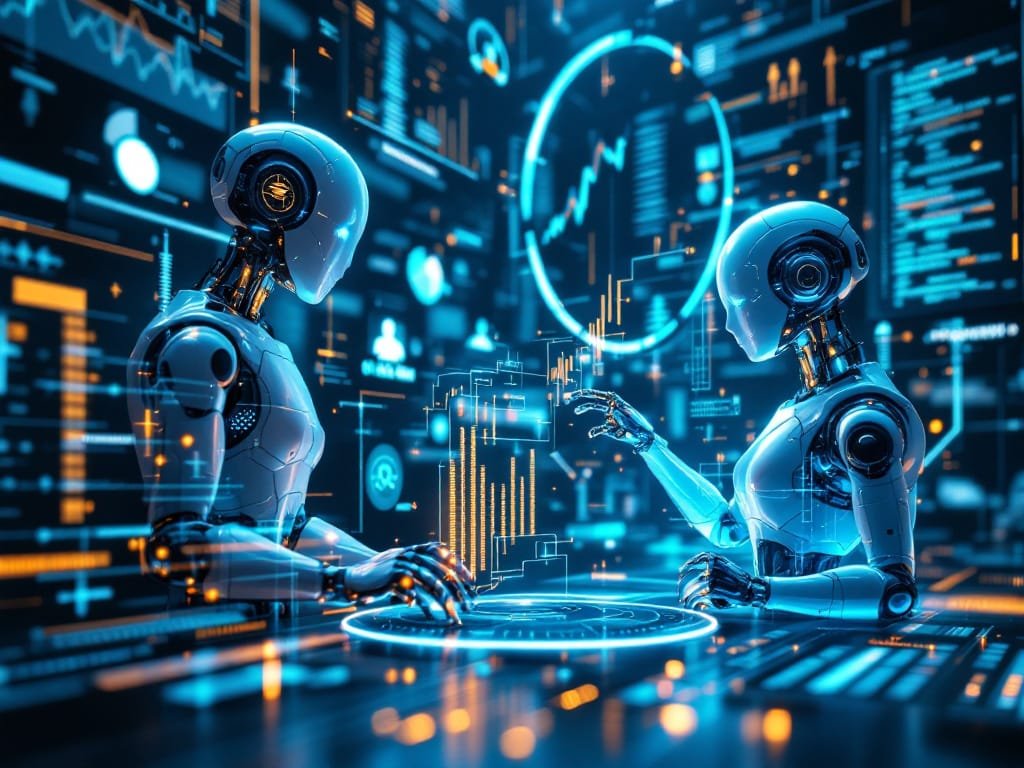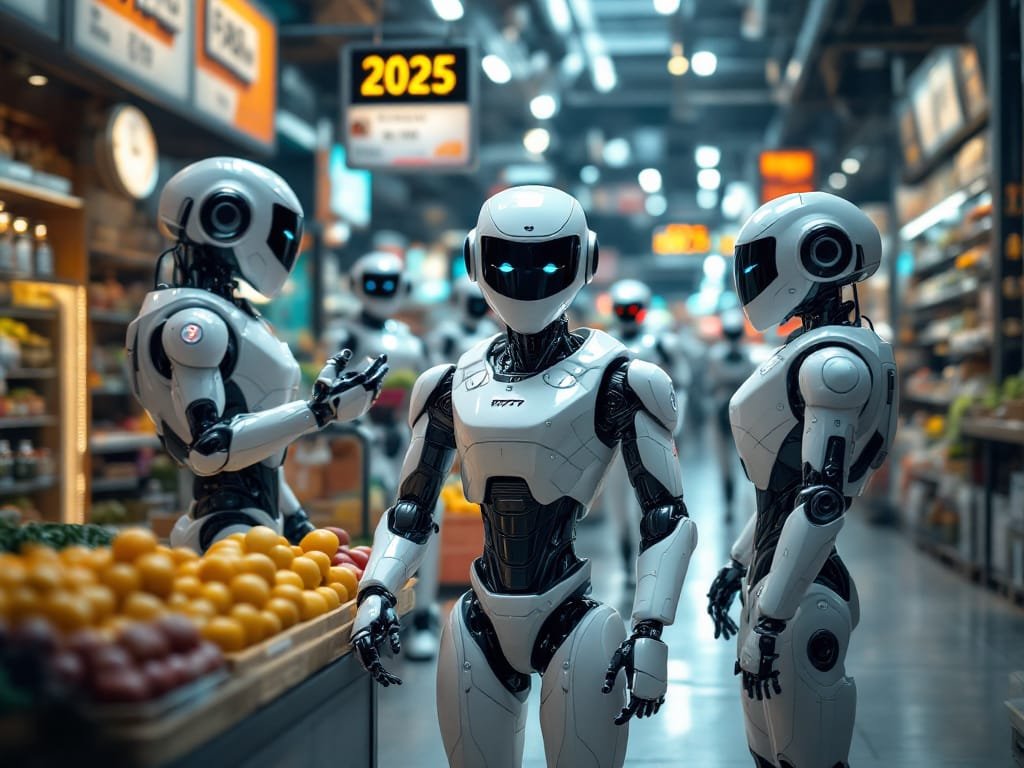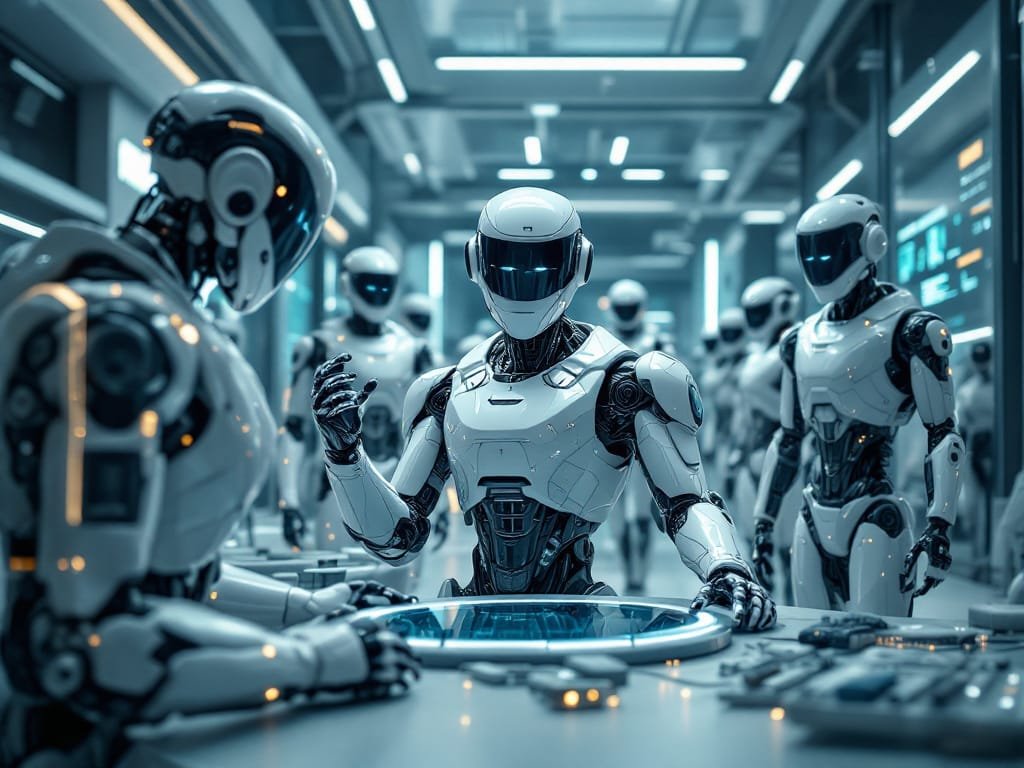Are AI Robots Real? The Truth About Humanoid Technology
Science fiction and reality keep getting blurrier when it comes to AI robots. Movies show smart robot buddies while news outlets hype up the latest humanoid breakthroughs. It’s hard to tell what’s real anymore. Are we about to get our own Rosie the Robot from The Jetsons, or are we just seeing fancy tech demos that can’t do much? Let’s check out what’s actually happening with AI robots today.
Are there any real AI robots?
Yes, AI robots exist, but not like the ones in sci-fi movies. Today’s AI robots mix physical hardware with software that learns and adapts. They’re nowhere near the self-aware machines Hollywood loves to show us, though.
Types of AI robots existing today
Current AI robots come in different shapes and sizes, with various skills and uses. Here are the main types you’ll find:
- Industrial robots: Super focused machines that do specific factory tasks with crazy precision.
- Humanoid robots: Machines built to look and move like humans, used in research, entertainment or customer service.
- Mobile robots: Self-driving machines that move around spaces for deliveries, security or exploration.
- Collaborative robots (cobots): Robots designed to work with humans, featuring better safety and easier controls.
- Social robots: Gadgets focused on talking to humans, often trying to understand emotions.
What makes today’s robots “smart” is their ability to learn. They use machine learning, computer vision, language processing, and sensors. Unlike old-school robots that just follow commands, these new ones can adapt to changes and get better with practice.
Applications in industries and research
AI robots are changing many fields in ways that go beyond just being cool tech toys:
In factories, robots like Boston Dynamics’ Stretch handle boring logistics tasks and adapt well. They use machine learning to get better at movement and recognizing objects the more they work.
Healthcare now uses robots for everything from surgery to patient care. Some help surgeons make tiny precise cuts better than human hands alone. Others like PARO help elderly patients by providing emotional support and brain stimulation.
Research teams use robots to explore places too dangerous for humans. Stanford’s OceanOne can dive 1,000 meters deep, letting operators “feel” underwater objects through feedback while AI keeps it stable in tricky currents.
In warehouses, AI robots from companies like Agility Robotics sort and move packages. They learn to navigate complex spaces and handle different package sizes. IEEE Spectrum reports that many now have human-like bodies to better work in spaces built for people.
Limitations of current AI robot technology
Despite cool advances, today’s AI robots face big challenges:
They’re clumsy with small stuff. While robots can move heavy things precisely in controlled settings, they struggle with tasks humans find easy—like folding clothes or picking up tiny objects in messy environments.
Battery life sucks. Most advanced robots run for just a few hours before needing a charge, which limits how useful they can be.
They don’t understand context or common sense. Robots can crunch huge amounts of data but lack the intuitive understanding humans develop from real-life experience.
The price tag is nuts. Advanced humanoid robots often cost hundreds of thousands or even millions, making them too expensive for most regular uses.
Most robots today are one-trick ponies. They’re great at specific jobs but terrible at applying their skills to new situations—something crucial for robots that would help around the house.
What is the most human AI robot?
The race to build human-like robots has heated up lately. Several contenders now look and act remarkably human, though each focuses on different aspects of being human-like.
Ameca: The world’s most advanced human-shaped robot
Ameca, built by UK company Engineered Arts in 2021, stands out as one of the best platforms for human-robot interaction. It’s gray and gender-neutral—not trying to look perfectly human. Instead, Ameca focuses on making facial expressions and interacting naturally.
What’s crazy impressive about Ameca is how its face moves. The robot can show surprise, confusion, interest, and other feelings through super natural facial expressions. Its face has tons of tiny motors controlling eyebrows, eyelids, lips, and other features with amazing detail.
Ameca mostly serves as a testbed for AI research. By providing a highly expressive robot body, researchers can test how humans and robots might communicate better. Ameca mixes pre-programmed moves with AI responses to create interactions that feel natural.
Unlike some other human-like robots, Ameca can’t walk around. It’s built as an upper-body robot that stays in one place, focused on social interaction rather than physical tasks.
Sophia and other realistic humanoids
Sophia, created by Hanson Robotics and switched on in 2016, got famous as one of the first humanoid robots to receive citizenship (from Saudi Arabia in 2017). With a face inspired by Audrey Hepburn and a see-through head showing its mechanical brain, Sophia takes a different approach—trying to look very human.
Sophia uses computer vision, language processing, and programmed responses to chat with people. It can recognize faces, keep eye contact, and respond to questions with some context. Sophia has been on talk shows, joined conferences, and even given speeches at the UN.
Other noteworthy humanoid robots pushing realism include:
- Geminoid DK: Made to look exactly like Danish professor Henrik Scharfe, this super realistic android helps study how humans interact with robots.
- BINA48: A head-and-shoulders robot designed to test if human consciousness could live in a machine, trying to copy a specific person’s personality and looks.
- Nadine: Built at a Singapore university, Nadine looks like its creator Professor Nadia Thalmann and remembers people it meets and past conversations.
Features that make these robots appear human-like
Several key features make advanced robots seem more human:
Facial expressions might be the most important part. Robots like Ameca use dozens of tiny motors to create subtle face movements, copying how humans show emotions. These systems map real human expressions and reproduce them with increasing accuracy.
Conversation skills play a huge role in seeming human. Modern humanoids use advanced language processing to grasp context, remember previous chats, and respond appropriately. Some, like Sophia, even try to crack jokes and make small talk.
Maintaining eye contact sounds simple but makes a big difference. Robots that can follow your gaze and focus on who’s talking to them create a stronger connection—it’s a subtle but crucial human trait.
Body language massively boosts the human-like effect. Robots that use hand gestures, head tilts, and posture shifts while talking seem way more natural than those that stay still.
Reacting to the unexpected makes robots seem alive. When a robot can jump at sudden movements or show interest in new objects, it feels much more like a living being.
The uncanny valley phenomenon
As robots get more human-like but not quite perfect, they often hit what roboticist Masahiro Mori called the “uncanny valley” back in 1970. This theory suggests almost-but-not-quite-human robots can make people feel uneasy or even grossed out.
The uncanny valley happens because tiny flaws become super noticeable as robots approach human appearance. Weird timing in facial expressions, unnatural blinking, or voices that don’t match the face can all trigger this creepy feeling.
Robot designers face a tough choice: try to make robots perfectly human (cross the valley) or deliberately make them look obviously non-human (avoid the valley entirely).
Companies like Engineered Arts chose the second path with Ameca, using a gray synthetic look while focusing on smooth movement. Others, like Hanson Robotics, try to push through the uncanny valley by constantly improving their robots’ human qualities.
Are robots with true AI capabilities coming to our homes?
The idea of having smart humanoid robots in our homes has been in sci-fi forever. But how close are we to actually making this happen?
Current state of household robots
Today’s home robots look nothing like the versatile robot assistants from movies. Most are one-job devices:
- Robot vacuums like Roomba are the most successful home robots, using sensors and mapping to clean floors without help.
- Robot lawn mowers use similar tech to cut grass on their own.
- Kitchen robots like Moley can cook specific recipes with some human help.
- Companion robots such as ElliQ offer conversation, reminders, and entertainment, especially for older folks.
The big problem with current home robots is their narrow focus. Unlike sci-fi robots, today’s home robots typically do just one thing. They lack the physical abilities, sensing capabilities, and general smarts needed for handling the messy reality of homes.
Most importantly, they can’t manipulate objects well—they can’t grab, move, and work with different things around the house. A robot that vacuums but can’t pick up toys, fold clothes, or load dishes isn’t all that useful.
Challenges in developing home-ready AI robots
Several huge hurdles stand between current tech and the household robots we dream about:
Homes are chaos for robots. Houses are unpredictable, constantly changing places full of irregular objects, different lighting, and unexpected obstacles. Teaching robots to handle such environments needs advanced sensors and decision-making beyond what we currently have.
Picking up and handling objects remains super hard for robots. Even simple tasks like folding laundry involve complex vision, planning, and fine motor control that robots struggle with.
Safety becomes critical in homes with kids, pets, and breakable stuff. Robots must reliably detect humans, adjust movements to avoid harm, and work safely even when surprising things happen.
Cost is a big barrier too. While factory robots can justify high prices through productivity gains, home robots need to be affordable while still being useful enough to justify their price.
Power consumption limits current designs. Many advanced humanoid robots use lots of electricity, enough to noticeably impact a home’s energy bill if used regularly. Built In’s analysis shows power consumption remains a key challenge for making humanoid robots practical at home.
Future projections for consumer robotics
Despite these challenges, several tech trends suggest home robots might become practical in the coming decades:
AI and machine learning keep getting better at helping robots understand and navigate complex environments. Neural networks trained on huge datasets enable increasingly sophisticated perception and decision-making.
Motor technology is improving, with newer designs bringing greater efficiency, precision, and durability. Bio-inspired systems may enable more natural and energy-efficient movement.
Component costs keep dropping, especially for sensors, processors, and mechanical parts. Mass production techniques borrowed from other industries further reduce costs as production scales up.
Industry experts think the first truly useful home robots will focus on specific high-value uses like helping the elderly, where even limited capabilities provide big benefits. These specialized robots might gradually evolve into more general assistants as technology improves.
But most experts believe truly versatile home robots—able to handle many different tasks with minimal human supervision—are still at least ten years away from being available at prices regular people can afford.
The Evolution of Humanoid Robots
From early prototypes to modern designs
Humanoid robots have come a long way over almost 100 years:
Elektro, the first real humanoid robot, showed up at the 1939 World’s Fair. This seven-foot-tall metal man could speak about 700 words and was a mechanical marvel for its time. It had no real intelligence though—just pre-recorded responses and basic mechanical tricks.
Japan’s Waseda University built WABOT-1 in the 1970s, making the first serious attempt at a functional humanoid. This robot had 3D vision, touch sensing, and basic walking skills. By 1984, WABOT-2 could even read music and play piano.
Honda shocked the world with ASIMO in 2000, after years of secret development. ASIMO could walk smoothly, climb stairs, and handle simple objects. Though Honda retired it in 2022, ASIMO showed bipedal robots were possible and inspired many other projects.
The 2010s brought more specialized humanoid robots. Boston Dynamics’ Atlas showed off incredible balance and agility, while SoftBank’s Pepper focused on talking to people in stores. Companies stopped trying to make do-everything robots and instead built machines for specific uses.
Today’s humanoids, like Tesla’s Optimus prototype and Apptronik’s Apollo, focus on practical uses and manufacturability. These newer designs aim to be cost-effective and useful rather than just research projects.
Key technological advancements
Several breakthrough technologies have powered the rapid evolution of humanoid robots:
Battery tech has been crucial in letting robots roam free. Early humanoids needed power cords or carried heavy batteries that died quickly. Modern lithium-ion and emerging solid-state batteries pack more energy in less space for longer operation.
Motors have transformed how robots move. Old hydraulic systems gave way to efficient electric motors, with newer designs adding springy elements for more natural, safer motion. Some cutting-edge designs use soft materials for safer human interaction.
Sensors have shrunk while getting more powerful. Early humanoids used basic cameras and crude pressure sensors. Today’s versions pack depth cameras, LIDAR, microphone arrays, force sensors, and motion trackers—all way smaller and cheaper than before.
Computing hardware lets robots think faster. Modern robots have powerful onboard computers, often with special AI chips to run complex neural networks for vision, planning, and control tasks.
Machine learning has completely changed how robots learn. Instead of just following programs, modern humanoids can learn from demonstrations, simulations, and real-world experience to keep improving their skills.
Notable companies leading robot development
Several organizations have taken the lead in humanoid robot development:
Boston Dynamics, started in 1992 as an MIT spin-off and now owned by Hyundai, pioneered dynamic movement with its Atlas humanoid. Their robots show off incredible agility, doing parkour and gymnastics moves. The company focuses on robots that can handle challenging real-world environments.
Tesla jumped into robotics with its Optimus prototype. Using its experience in AI, manufacturing, and batteries, Tesla aims to mass-produce affordable humanoids. CEO Elon Musk thinks robots could eventually become a bigger business than Tesla’s cars.
Engineered Arts builds expressive humanoids for entertainment and research. Their Ameca robot, with its smooth facial expressions, provides a platform for studying human-robot interaction. The company focuses on natural expression over practical functions.
Agility Robotics created Digit, a humanoid specifically for logistics. With a body designed to navigate human spaces while carrying packages, Digit takes a more specialized approach focused on immediate practical use.
Sanctuary AI takes a different route with their Phoenix robot, emphasizing remote control by humans. This lets the robot do complex tasks right away while its AI learns from watching humans.
Chinese company Unitree Robotics focuses on making cheaper humanoid platforms, with their H1 robot costing less than competitors while maintaining useful capabilities.
Applications of Modern Humanoid Robots
Industrial and manufacturing uses
Factories are increasingly using humanoid robots, where their ability to use human tools offers big advantages:
Car factories are testing humanoids from companies like Apptronik for assembly tasks alongside human workers. These robots can switch between different jobs without needing special tools for each task, saving money when production needs change.
For fixing complex equipment, humanoids can reach areas designed for human techs. This helps in places like power plants or oil refineries, where spaces are built for humans but might be dangerous for people to access.
In warehouses, companies including Amazon are trying out humanoid robots to work with their existing automation. Two-legged robots can handle stairs, curbs, and obstacles that stop wheeled robots. Agility Robotics’ Digit has started working in pilot programs moving packages around warehouses.
The main advantage humanoids bring to factories is flexibility. While special-purpose factory robots beat humanoids at specific repeated tasks, humanoids can switch between different jobs without physical changes. This makes them great for small-batch, varied production.
Healthcare and assistance applications
Healthcare might be where humanoid robots make their biggest impact:
In elder care, robots help with physical tasks that strain human caregivers. Japan, with its rapidly aging population, has invested heavily in robots that can move patients between beds and wheelchairs, help with walking, and provide basic physical support.
Rehab robots use humanoid designs to show exercises and help during therapy. These robots can demonstrate perfect form and provide consistent support during practice, working alongside human therapists.
Hospital logistics increasingly use robots for delivering meds, transporting samples, and moving equipment. While often using wheels instead of legs, they have humanoid upper bodies to use elevators, open doors, and interact with hospital systems.
Social support robots address emotional needs in healthcare. Designs like PARO (a seal-shaped robot) and more humanoid versions provide companionship and mental stimulation for dementia patients or isolated individuals. Reddit discussions suggest these social robots currently work better than physical helper robots in homes.
Entertainment and service industry roles
Entertainment and service businesses have jumped on the humanoid robot bandwagon:
Theme parks now feature humanoid robots as entertainers or guides. Disney’s famous animatronics have evolved into interactive characters, while Universal Studios and others use robots for consistent character interactions that don’t need breaks during long park hours.
Hotels use humanoid robots as greeters, front desk staff, and novelty attractions. Japanese hotels pioneered robot check-in, while restaurants worldwide have tried robot servers. The KIME robot, made by Macco Robotics, can serve four drinks per minute in bars.
Retail stores deploy humanoids to show off products and help customers. These robots provide consistent information while drawing curious shoppers in competitive retail settings.
Movie and TV production uses humanoid robots for shots that would be dangerous or impossible for human actors. The entertainment world also pushes development of realistic robot faces and bodies that later influence practical applications.
Schools use humanoid robots to get kids excited about STEM subjects. Platforms like NAO from SoftBank Robotics are built for education, letting students program robot behaviors while learning about tech, math, and physics.
Conclusion
AI robotics in 2023 shows an interesting mix of amazing progress and stubborn limitations. We’ve seen robots doing backflips, having natural conversations, and moving more smoothly—yet the dream of helpful home robots remains mostly unfulfilled.
What’s obvious is that development is speeding up. Better AI, improved hardware, cheaper parts, and more investment are pushing humanoid robotics forward faster than ever. Companies from veterans like Boston Dynamics to newcomers like Tesla and Figure keep pushing the limits of what’s possible.
Expect humanoid robots to first succeed in structured places like warehouses, factories, and specialized care settings before moving into messier environments like homes. The path to truly capable all-purpose robots will probably involve mastering specific valuable tasks first, then expanding their skills over time.
If you’re wondering when you’ll get your own robot helper, you’ll need some patience. The gap between today’s tech and sci-fi robots is getting smaller, but big challenges in dexterity, adaptability, cost, and safety remain. Home robots in the next decade will likely be specialized helpers rather than do-everything humanoids.
Going forward, the most successful robots might not be the ones that look most human, but those that balance capability, practicality, and affordability while solving real problems. The future of robotics isn’t just about what we can build—it’s about creating machines that actually make our lives better while addressing the economic, ethical, and social questions they inevitably raise.
Share this content:



